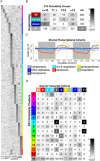The structural code of cyanobacterial genomes
- PMID: 25056315
- PMCID: PMC4132750
- DOI: 10.1093/nar/gku641
The structural code of cyanobacterial genomes
Abstract
A periodic bias in nucleotide frequency with a period of about 11 bp is characteristic for bacterial genomes. This signal is commonly interpreted to relate to the helical pitch of negatively supercoiled DNA. Functions in supercoiling-dependent RNA transcription or as a 'structural code' for DNA packaging have been suggested. Cyanobacterial genomes showed especially strong periodic signals and, on the other hand, DNA supercoiling and supercoiling-dependent transcription are highly dynamic and underlie circadian rhythms of these phototrophic bacteria. Focusing on this phylum and dinucleotides, we find that a minimal motif of AT-tracts (AT2) yields the strongest signal. Strong genome-wide periodicity is ancestral to a clade of unicellular and polyploid species but lost upon morphological transitions into two baeocyte-forming and a symbiotic species. The signal is intermediate in heterocystous species and weak in monoploid picocyanobacteria. A pronounced 'structural code' may support efficient nucleoid condensation and segregation in polyploid cells. The major source of the AT2 signal are protein-coding regions, where it is encoded preferentially in the first and third codon positions. The signal shows only few relations to supercoiling-dependent and diurnal RNA transcription in Synechocystis sp. PCC 6803. Strong and specific signals in two distinct transposons suggest roles in transposase transcription and transpososome formation.
© The Author(s) 2014. Published by Oxford University Press on behalf of Nucleic Acids Research.
Figures





References
Publication types
MeSH terms
Substances
LinkOut - more resources
Full Text Sources
Other Literature Sources
Molecular Biology Databases

